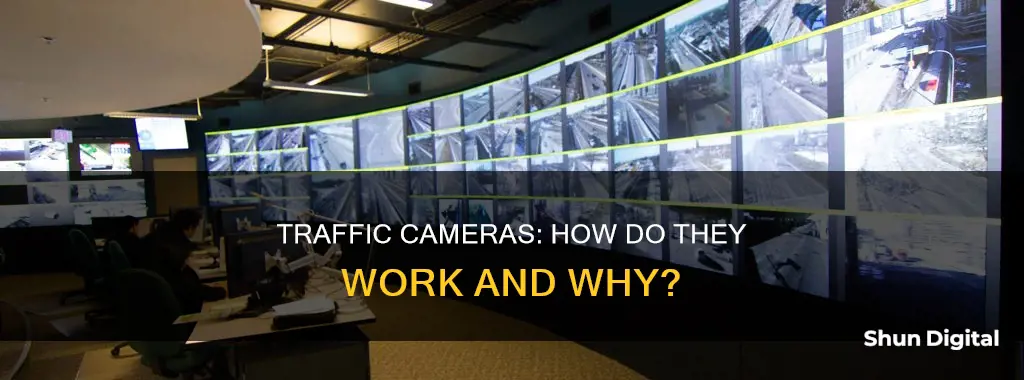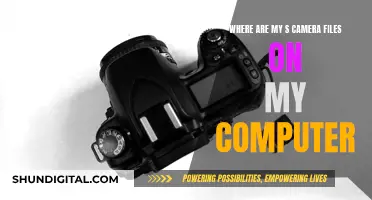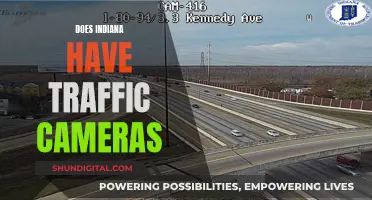
Traffic monitoring cameras are an increasingly common sight on roads and highways. Mounted on poles, bridges, or traffic lights, these cameras are used to monitor traffic flow and road conditions, detect accidents, and enforce road safety. They can also be used to enforce traffic laws, such as by issuing tickets to drivers who run red lights or speed. While some people argue that these cameras improve road safety and help reduce accidents, others criticise them as an example of Big Brother tactics and a way for governments to raise revenue.
| Characteristics | Values |
|---|---|
| Purpose | Safety, traffic flow, road and transport management, law enforcement, data collection |
| Installation Type | Fixed, portable, mobile |
| Mounting | Poles, bridges, traffic light poles, gantries, patrol cars, buildings |
| Functionality | Vehicle identification, automatic number plate recognition, speed measurement, traffic violation detection, real-time monitoring, data collection, incident detection |
| Technology | Radar, laser, infrared, optical character recognition, artificial intelligence |
What You'll Learn
- Traffic monitoring cameras are placed at strategic locations to provide a comprehensive view of traffic flow and conditions
- They are connected to a control centre where the images can be viewed in real-time
- Some cameras are equipped with sensors that can detect the speed of vehicles, allowing authorities to enforce traffic laws
- Traffic monitoring cameras can help lower accidents in accident-prone areas and reduce road traffic collisions
- They are also used for tolling and maintaining smooth passenger flow

Traffic monitoring cameras are placed at strategic locations to provide a comprehensive view of traffic flow and conditions
Traffic monitoring cameras are placed strategically along roads and highways to capture a comprehensive view of traffic flow and conditions. These cameras are typically mounted on poles, bridges, or other structures at intersections, on-ramps, and other areas prone to heavy congestion. Their placement ensures a comprehensive view, aiding traffic management and safety.
The cameras are connected to a control centre or network, allowing traffic engineers and law enforcement personnel to view footage in real-time. This enables the monitoring of traffic flow, the detection of accidents, and the implementation of necessary actions. They are often used in conjunction with other systems, such as parking lot surveillance cameras, to enhance security and traffic management strategies.
Traffic monitoring cameras may be equipped with various features and sensors. Some can detect vehicle speed, aiding in traffic law enforcement and the issuance of tickets for speeding. Others may have infrared technology for clear imaging in low-light or night-time conditions.
These cameras play a crucial role in enhancing road safety and reducing accidents. By monitoring traffic flow, they assist in identifying areas of congestion and implementing measures to improve traffic conditions. Additionally, the cameras help in detecting and responding to accidents promptly, improving the efficiency of emergency services.
The data collected by traffic monitoring cameras is valuable for city planning and transportation management. It aids in understanding traffic patterns, enabling engineers and planners to make informed decisions when designing new roads or implementing traffic management strategies. This data-driven approach contributes to the development of efficient transportation infrastructure and improved road safety.
In summary, traffic monitoring cameras are strategically placed to capture a comprehensive view of traffic. They aid in real-time traffic management, enhance road safety, and provide valuable data for city planning. These cameras play a vital role in improving traffic flow, reducing accidents, and making informed decisions about transportation infrastructure.
Baltimore Camera Tickets: Your Guide to Fight Fines
You may want to see also

They are connected to a control centre where the images can be viewed in real-time
Traffic monitoring cameras are typically placed at strategic locations, such as complex intersections, roads with heavy congestion, or areas with extreme weather conditions. Once installed, these cameras are connected to a control centre or network, where their images can be viewed in real-time. This setup allows traffic engineers and law enforcement personnel to monitor traffic flow, detect accidents, and take appropriate action when necessary.
The control centre receives a live feed from the cameras, providing a comprehensive view of traffic conditions. This enables authorities to make informed decisions and respond promptly to any incidents or disruptions. The real-time data helps in managing traffic flow and improving road safety.
In addition to monitoring, these cameras can also be used for traffic enforcement. For instance, some cameras are equipped with speed detection technology, allowing authorities to enforce speed limits and issue tickets to speeding drivers. This integration of advanced technology enhances the capabilities of the traffic monitoring system.
The use of traffic monitoring cameras has been proven to reduce accidents and improve road safety. According to studies, these cameras can lower accidents in accident-prone areas and reduce road traffic collisions by up to 15%. The presence of cameras also acts as a deterrent, encouraging drivers to follow traffic rules and speed limits, which further contributes to safer roads.
By connecting the cameras to a control centre, relevant authorities can efficiently utilise the real-time data to make timely decisions and ensure the smooth flow of traffic. This integration of technology and human expertise enhances the overall effectiveness of the traffic monitoring system.
Unlocking Macro Photography: Mastering Camera's Macro Focus
You may want to see also

Some cameras are equipped with sensors that can detect the speed of vehicles, allowing authorities to enforce traffic laws
Traffic monitoring cameras are an important tool for road safety and traffic management. Placed strategically at complex intersections, congested roads, or areas with extreme weather conditions, these cameras help authorities keep a close eye on traffic flow and road conditions.
While the primary purpose of these cameras is to improve road safety and reduce accidents, some cameras are also equipped with additional features to enhance their functionality. One such feature is the ability to detect vehicle speed.
Some traffic monitoring cameras are indeed equipped with sensors that can accurately measure the speed of vehicles. This capability is crucial for enforcing traffic laws and ensuring drivers adhere to speed limits. By detecting speeding vehicles, these cameras enable authorities to take appropriate action, such as issuing tickets to drivers who are endangering themselves and others by driving too fast.
The inclusion of speed sensors in traffic monitoring cameras is a significant advancement in road safety. It allows for a more comprehensive approach to traffic management, combining real-time video footage with speed data. This integration provides authorities with valuable information to make informed decisions and take prompt action when necessary.
Speed sensors in traffic cameras utilize various technologies, such as radar and laser-based speed measurement, to accurately capture vehicle speed. Additionally, when integrated into an Intelligent Transportation System (ITS), these cameras can measure average speeds by calculating the time taken for a vehicle to travel between two points.
The presence of speed sensors in traffic monitoring cameras acts as a deterrent to speeding, encouraging drivers to follow the prescribed speed limits. This not only improves road safety but also helps maintain a smooth flow of traffic, reducing congestion and the likelihood of accidents.
In conclusion, the inclusion of sensors that detect vehicle speed in traffic monitoring cameras is a powerful tool for authorities to enforce traffic laws, promote safe driving, and enhance overall road safety. By combining video footage with speed data, these cameras play a vital role in modern traffic management systems.
Best Doorbell Cameras Without Monthly Fees
You may want to see also

Traffic monitoring cameras can help lower accidents in accident-prone areas and reduce road traffic collisions
Traffic monitoring cameras are an essential tool in the effort to improve road safety and reduce accidents. They are typically mounted on poles, bridges, or traffic light poles and placed at strategic locations such as complex intersections, accident-prone areas, or roads with frequent congestion. These cameras serve multiple purposes, including lowering accidents, enforcing traffic laws, and improving traffic flow.
One of their key functions is to help lower accidents in accident-prone areas and reduce road traffic collisions. By monitoring traffic in real-time, these cameras enable traffic engineers and law enforcement personnel to detect accidents promptly and take appropriate action. For instance, if a car is pulled over, the camera system can alert transportation officials, who can then assess the situation and dispatch assistance if necessary. This enhances incident response and improves road safety.
Additionally, traffic monitoring cameras can play a role in reducing traffic violations that often lead to accidents. Red light cameras, for example, capture images of vehicles running red lights, providing evidence for traffic violations. These cameras are typically placed at busy intersections to deter motorists from violating stop lights. Similarly, speed cameras monitor compliance with speed limits and can detect when a vehicle is exceeding the speed limit, allowing authorities to enforce traffic laws and issue tickets to speeding drivers.
Beyond accident reduction, traffic monitoring cameras aid in maintaining smooth traffic flow. They provide comprehensive data on traffic conditions, allowing transportation officials to make informed decisions and implement effective traffic management strategies. This helps alleviate congestion and improve the efficiency of road networks.
In conclusion, traffic monitoring cameras are a valuable tool for enhancing road safety and reducing accidents. They achieve this through real-time monitoring, accident detection, traffic data collection, and enforcement of traffic laws. By utilizing these cameras, transportation authorities can make roads safer and reduce the number of accidents, ultimately protecting motorists and passers-by.
Fighting Camera Tickets: Your Rights in Ventura County
You may want to see also

They are also used for tolling and maintaining smooth passenger flow
Traffic monitoring cameras are often used for tolling and maintaining smooth passenger flow. They are typically mounted on traffic light poles or gantries and are used to monitor the roads and traffic, mostly for safety reasons.
One of the key functions of traffic monitoring cameras is vehicle identification, which detects if a vehicle is present and triggers the camera to capture an image. This is also called triggering and is highly recommended for Automatic Number Plate Recognition (ANPR). ANPR is a traffic surveillance method based on optical character recognition (OCR) that uses a specific OCR algorithm to process captured images or footage to recognize the plate characters.
Traffic monitoring cameras are also often used for measuring speed and are referred to as speed cameras. These camera models can detect speedsters and can be used to check the flow of traffic and automatically identify traffic congestions. Speed cameras utilize different types of technology to measure speed, including radar and laser-based speed measurement.
In addition to tolling and maintaining smooth passenger flow, traffic monitoring cameras can also be used to detect traffic violations. These cameras can efficiently process live streams and use advanced AI technology to identify any irregular driver behaviour that may cause problems in traffic. They can detect traffic offences such as not using seatbelts and exceeding the speed limit.
By utilizing traffic monitoring cameras for tolling and maintaining smooth passenger flow, transportation officials can improve road safety, reduce congestion, and enhance the overall efficiency of the road network.
Why 18650 Batteries Are Popular in Cameras
You may want to see also
Frequently asked questions
Traffic monitoring cameras are used to monitor the roads and traffic, mostly for safety reasons. They can also be used for tolling and maintaining smooth passenger flow.
Traffic monitoring cameras are typically placed at strategic locations along roads and highways, such as complex intersections, roads with heavy traffic, or areas with extreme weather conditions. They may be mounted on poles, bridges, or other structures.
Traffic monitoring cameras are connected to a control centre or network, where authorised personnel can view the captured images in real-time. This allows for the monitoring of traffic flow, detection of accidents, and enforcement of traffic laws.
Traffic monitoring cameras can help reduce accidents, improve traffic flow, and enhance incident response. They also provide valuable data for city planning and transportation management.







